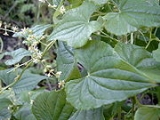
Black Bryony
Encyclopedia
Dioscorea communis is a species of flowering plant
in the yam family Dioscoreaceae
and is commonly known as Black Bryony.
plant growing to 2-4 m tall, with twining
stems. The leaves
are spirally arranged, heart-shaped, up to 10 cm long and 8 cm broad, with a petiole up to 5 cm long. It is dioecious
, with separate male and female plants. The flower
s are individually inconspicuous, greenish-yellow, 3-6 mm diameter, with six petals; the male flowers produced in slender 5-10 cm raceme
s, the female flowers in shorter clusters. The fruit
is a bright red berry
, 1 cm diameter. Its fairly large tuber
is, like the rest of the plant, poison
ous.
, northwest Africa
and western Asia
.
Flowering plant
The flowering plants , also known as Angiospermae or Magnoliophyta, are the most diverse group of land plants. Angiosperms are seed-producing plants like the gymnosperms and can be distinguished from the gymnosperms by a series of synapomorphies...
in the yam family Dioscoreaceae
Dioscoreaceae
Dioscoreaceae is a family of monocotyledonous flowering plants, with about 750 species in eight or nine genera. The best-known member of the family is the Yam ....
and is commonly known as Black Bryony.
Description
It is a climbing herbaceousHerbaceous
A herbaceous plant is a plant that has leaves and stems that die down at the end of the growing season to the soil level. They have no persistent woody stem above ground...
plant growing to 2-4 m tall, with twining
Twining
-Places:In the United States:*Twining, Michigan, a village*Twining, Washington, D.C., a neighborhood-Other uses:*A type of basket weaving*Plants growing upwards by revolving around and leaning on a supporting structure. They are neither climbing, nor freely upright.*Twining Models, an English...
stems. The leaves
Leaf
A leaf is an organ of a vascular plant, as defined in botanical terms, and in particular in plant morphology. Foliage is a mass noun that refers to leaves as a feature of plants....
are spirally arranged, heart-shaped, up to 10 cm long and 8 cm broad, with a petiole up to 5 cm long. It is dioecious
Plant sexuality
Plant sexuality covers the wide variety of sexual reproduction systems found across the plant kingdom. This article describes morphological aspects of sexual reproduction of plants....
, with separate male and female plants. The flower
Flower
A flower, sometimes known as a bloom or blossom, is the reproductive structure found in flowering plants . The biological function of a flower is to effect reproduction, usually by providing a mechanism for the union of sperm with eggs...
s are individually inconspicuous, greenish-yellow, 3-6 mm diameter, with six petals; the male flowers produced in slender 5-10 cm raceme
Raceme
A raceme is a type of inflorescence that is unbranched and indeterminate and bears pedicellate flowers — flowers having short floral stalks called pedicels — along the axis. In botany, axis means a shoot, in this case one bearing the flowers. In a raceme, the oldest flowers are borne...
s, the female flowers in shorter clusters. The fruit
Fruit
In broad terms, a fruit is a structure of a plant that contains its seeds.The term has different meanings dependent on context. In non-technical usage, such as food preparation, fruit normally means the fleshy seed-associated structures of certain plants that are sweet and edible in the raw state,...
is a bright red berry
Berry
The botanical definition of a berry is a fleshy fruit produced from a single ovary. Grapes are an example. The berry is the most common type of fleshy fruit in which the entire ovary wall ripens into an edible pericarp. They may have one or more carpels with a thin covering and fleshy interiors....
, 1 cm diameter. Its fairly large tuber
Tuber
Tubers are various types of modified plant structures that are enlarged to store nutrients. They are used by plants to survive the winter or dry months and provide energy and nutrients for regrowth during the next growing season and they are a means of asexual reproduction...
is, like the rest of the plant, poison
Poison
In the context of biology, poisons are substances that can cause disturbances to organisms, usually by chemical reaction or other activity on the molecular scale, when a sufficient quantity is absorbed by an organism....
ous.
Distribution
Dioscorea communis is a native spontaneous species widespread throughout EuropeEurope
Europe is, by convention, one of the world's seven continents. Comprising the westernmost peninsula of Eurasia, Europe is generally 'divided' from Asia to its east by the watershed divides of the Ural and Caucasus Mountains, the Ural River, the Caspian and Black Seas, and the waterways connecting...
, northwest Africa
Africa
Africa is the world's second largest and second most populous continent, after Asia. At about 30.2 million km² including adjacent islands, it covers 6% of the Earth's total surface area and 20.4% of the total land area...
and western Asia
Asia
Asia is the world's largest and most populous continent, located primarily in the eastern and northern hemispheres. It covers 8.7% of the Earth's total surface area and with approximately 3.879 billion people, it hosts 60% of the world's current human population...
.

